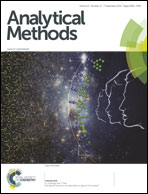Highly efficient turn-on fluorescence detection of zinc(ii) based on multi-ligand metal chelation†
Abstract
We report that the simple Schiff base molecule, 2-(((pyridin-2-ylmethyl)imino)methyl)phenol, can efficiently chelate zinc(II) to produce a highly fluorescent complex, ML2, which could be useful in the development of turn-on fluorescence detection of zinc(II). The compound initially shows very weak fluorescence, however, the coordination with the zinc ion inhibits the C![[double bond, length as m-dash]](https://www.rsc.org/images/entities/char_e001.gif) N bond isomerization and subsequently enhances the fluorescence efficiency. Based on the turn-on fluorescence, the limit of detection for zinc(II) was measured to be 62 nM, which is lower than the allowable level of zinc (∼70 μM) in drinking water set by the U.S. Environmental Protection Agency. We tried to make fluorescence test strips by immobilizing the compound in silica gel plates and demonstrated the application for visualization of zinc screening in water and aerosol samples. The visual limit of detection was estimated to be as low as 9 μM.
N bond isomerization and subsequently enhances the fluorescence efficiency. Based on the turn-on fluorescence, the limit of detection for zinc(II) was measured to be 62 nM, which is lower than the allowable level of zinc (∼70 μM) in drinking water set by the U.S. Environmental Protection Agency. We tried to make fluorescence test strips by immobilizing the compound in silica gel plates and demonstrated the application for visualization of zinc screening in water and aerosol samples. The visual limit of detection was estimated to be as low as 9 μM.


 Please wait while we load your content...
Please wait while we load your content...